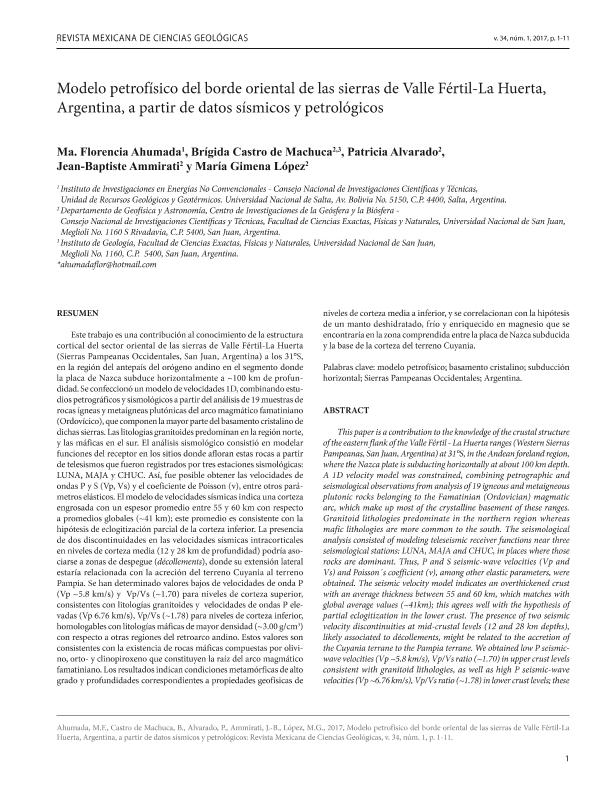Artículo
Este trabajo es una contribución al conocimiento de la estructura cortical del sector oriental de las sierras de Valle Fértil-La Huerta (Sierras Pampeanas Occidentales, San Juan, Argentina) a los 31°S, en la región del antepaís del orógeno andino en el segmento donde la placa de Nazca subduce horizontalmente a ~100 km de profundidad. Se confeccionó un modelo de velocidades 1D, combinando estudios petrográficos y sismológicos a partir del análisis de 19 muestras de rocas ígneas y metaígneas plutónicas del arco magmático famatiniano (Ordovícico), que componen la mayor parte del basamento cristalino de dichas sierras. Las litologías granitoides predominan en la región norte, y las máficas en el sur. El análisis sismológico consistió en modelar funciones del receptor en los sitios donde afloran estas rocas a partir de telesismos que fueron registrados por tres estaciones sismológicas: LUNA, MAJA y CHUC. Así, fue posible obtener las velocidades de ondas P y S (Vp, Vs) y el coeficiente de Poisson (ν), entre otros parámetros elásticos. El modelo de velocidades sísmicas indica una corteza engrosada con un espesor promedio entre 55 y 60 km con respecto a promedios globales (~41 km); este promedio es consistente con la hipótesis de eclogitización parcial de la corteza inferior. La presencia de dos discontinuidades en las velocidades sísmicas intracorticales en niveles de corteza media (12 y 28 km de profundidad) podría asociarse a zonas de despegue (décollements), donde su extensión lateral estaría relacionada con la acreción del terreno Cuyania al terreno Pampia. Se han determinado valores bajos de velocidades de onda P (Vp ~5.8 km/s) y Vp/Vs (~1.70) para niveles de corteza superior, consistentes con litologías granitoides y velocidades de ondas P elevadas (Vp 6.76 km/s), Vp/Vs (~1.78) para niveles de corteza inferior, homologables con litologías máficas de mayor densidad (~3.00 g/cm3) con respecto a otras regiones del retroarco andino. Estos valores son consistentes con la existencia de rocas máficas compuestas por olivino, orto- y clinopiroxeno que constituyen la raíz del arco magmático famatiniano. Los resultados indican condiciones metamórficas de alto grado y profundidades correspondientes a propiedades geofísicas de niveles de corteza media a inferior, y se correlacionan con la hipótesis de un manto deshidratado, frío y enriquecido en magnesio que se encontraría en la zona comprendida entre la placa de Nazca subducida y la base de la corteza del terreno Cuyania. This paper is a contribution to the knowledge of the crustal structure of the eastern flank of the Valle Fértil - La Huerta ranges (Western Sierras Pampeanas, San Juan, Argentina) at 31°S, in the Andean foreland region, where the Nazca plate is subducting horizontally at about 100 km depth. A 1D velocity model was constrained, combining petrographic and seismological observations from analysis of 19 igneous and metaigneous plutonic rocks belonging to the Famatinian (Ordovician) magmatic arc, which make up most of the crystalline basement of these ranges. Granitoid lithologies predominate in the northern region whereas mafic lithologies are more common to the south. The seismological analysis consisted of modeling teleseismic receiver functions near three seismological stations: LUNA, MAJA and CHUC, in places where those rocks are dominant. Thus, P and S seismic-wave velocities (Vp and Vs) and Poisson´s coefficient (ν), among other elastic parameters, were obtained. The seismic velocity model indicates an overthickened crust with an average thickness between 55 and 60 km, which matches with global average values (~41km); this agrees well with the hypothesis of partial eclogitization in the lower crust. The presence of two seismic velocity discontinuities at mid-crustal levels (12 and 28 km depths), likely associated to décollements, might be related to the accretion of the Cuyania terrane to the Pampia terrane. We obtained low P seismic-wave velocities (Vp ~5.8 km/s), Vp/Vs ratio (~1.70) in upper crust levels consistent with granitoid lithologies, as well as high P seismic-wave velocities (Vp ~6.76 km/s), Vp/Vs ratio (~1.78) in lower crust levels; these figures match with mafic lithologies of a more dense (~3.00 g/cm3), lower crust with respect to other back-arc Andean regions. Also, these values are consistent with the existence of mafic rocks composed of olivine, ortho-and clinopyroxene, which constitute the root of the Famatinian magmatic arc. These results indicate high-grade metamorphic conditions and depths corresponding to geophysical properties of middle to lower crust and correlate with the hypothesis of a dehydrated, cool and magnesium-enriched mantle located in the region between the subducted Nazca slab and the bottom of the Cuyania terrain crust.
Modelo petrofísico del borde oriental de las sierras de Valle Fértil-La Huerta, Argentina, a partir de datos sísmicos y petrológicos
Título:
Petrophysical model of the eastern flank of Valle Fertil - La huerta ranges, Argentina, from seismic and petrological data
Ahumada, Maria Florencia ; Castro, Brigida Marta Ester
; Castro, Brigida Marta Ester ; Alvarado, Patricia Monica
; Alvarado, Patricia Monica ; Ammirati, Jean Baptiste
; Ammirati, Jean Baptiste ; Lopez, Maria Gimena
; Lopez, Maria Gimena
 ; Castro, Brigida Marta Ester
; Castro, Brigida Marta Ester ; Alvarado, Patricia Monica
; Alvarado, Patricia Monica ; Ammirati, Jean Baptiste
; Ammirati, Jean Baptiste ; Lopez, Maria Gimena
; Lopez, Maria Gimena
Fecha de publicación:
04/2017
Editorial:
Universidad Nacional Autónoma de México. Centro de Geociencias
Revista:
Revista Mexicana de Ciencias Geológicas
ISSN:
1026-8774
e-ISSN:
2007-2902
Idioma:
Español
Tipo de recurso:
Artículo publicado
Clasificación temática:
Resumen
Archivos asociados
Licencia
Identificadores
Colecciones
Articulos(CIGEOBIO)
Articulos de CENTRO DE INVESTIGACIONES DE LA GEOSFERA Y BIOSFERA
Articulos de CENTRO DE INVESTIGACIONES DE LA GEOSFERA Y BIOSFERA
Citación
Ahumada, Maria Florencia; Castro, Brigida Marta Ester; Alvarado, Patricia Monica; Ammirati, Jean Baptiste; Lopez, Maria Gimena; Modelo petrofísico del borde oriental de las sierras de Valle Fértil-La Huerta, Argentina, a partir de datos sísmicos y petrológicos; Universidad Nacional Autónoma de México. Centro de Geociencias; Revista Mexicana de Ciencias Geológicas; 34; 1; 4-2017; 1-11
Compartir



